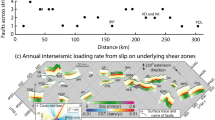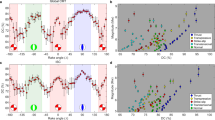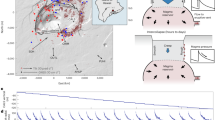Abstract
An earthquake alters the shear and normal stress on surrounding faults. New evidence strengthens the hypothesis that such small, sudden stress changes cause large changes in seismicity rate. Rates climb where the stress increases (aftershocks) and fall where the stress drops. Both increases and decreases in seismicity rate are followed by a time-dependent recovery. When stress change is translated into probability change, seismic hazard is seen to be strongly influenced by earthquake interaction.
This is a preview of subscription content, access via your institution
Access options
Subscribe to this journal
Receive 51 print issues and online access
$199.00 per year
only $3.90 per issue
Buy this article
- Purchase on Springer Link
- Instant access to full article PDF
Prices may be subject to local taxes which are calculated during checkout






Similar content being viewed by others
References
Bakun,W. H. Seismic activity of the San Francisco Bay region. Bull. Seismol. Soc. Am. 89, 764–784 (1999).
Lay,T., Astiz,L., Kanamori,H. & Christensen,D. H. Temporal variation of large interplate earthquakes in coupled subduction zones. Phys. Earth Planet. Inter. 54, 258–312 (1989).
Chinnery,M. A. The stress changes that accompany strike-slip faulting. Bull. Seismol. Soc. Am. 53, 921–932 (1963).
Das,S. & Scholz,C. H. Off-fault aftershock clusters caused by shear stress increase? Bull. Seismol. Soc. Am. 71, 1669–1675 (1981).
Stein,R. S. & Lisowski,M. The 1979 Homestead Valley earthquake sequence, California: Control of aftershocks and postseismic deformation. J. Geophys. Res. 88, 6477–6490 (1983).
Oppenheimer,D. H., Reasenberg,P. A. & Simpson,R. W. Fault plane solutions for the 1984 Morgan Hill, California, earthquake sequence: Evidence for the state of stress on the Calaveras fault. J. Geophys. Res. 93, 9007–9026 (1988).
King,G. C. P., Stein,R. S. & Lin,J. Static stress changes and the triggering of earthquakes. Bull. Seismol. Soc. Am. 84, 935–953 (1994).
Stein,R. S., King,G. C. P. & Lin,J. Change in failure stress on the southern San Andreas fault system caused by the 1992 magnitude = 7.4 Landers earthquake. Science 258, 1328–1332 (1992).
Harris,R. A. & Simpson,R. W. Changes in static stress on southern California faults after the 1992 Landers earthquake. Nature 360, 251–254 (1992).
Jaumé,S. C. & Sykes,L. R. Change in the state of stress on the southern San Andreas fault resulting from the California earthquake sequence of April to June 1992. Science 258, 1325–1328 (1992).
Gross,S. & Kisslinger,C. Estimating tectonic stress rate and state with Landers aftershocks. J. Geophys. Res. 102, 7603–7612 (1997).
Harris,R. A. Introduction to special session: Stress triggers, stress shadows, and implications for seismic hazard. J. Geophys. Res. 103, 24347–24358 (1998).
Reasenberg,P. A. & Simpson,R. W. Response of regional seismicity to the static stress change produced by the Loma Prieta earthquake. Science 255, 1687–1690 (1992).
Simpson,R. W. & Reasenberg,P. A. in The Loma Prieta, California, Earthquake of October 17, 1989—Tectonic Processes and Models (ed. Simpson, R. W.) F55–F89 (Professional Paper 1550-F, US Geological Survey, 1994).
Parsons,T., Stein,R. S., Simpson,R. W. & Reasenberg,P. A. Stress sensitivity of fault seismicity: A comparison between limited-offset oblique and major strike-slip faults. J. Geophys. Res. 104, 20183–120202 (1999).
Zoback,M. D. et al. New evidence on the state of stress of the San Andreas fault system. Science 238, 1105–1111 (1987).
Rice,J. R. in Fault Mechanics and Transport Properties of Rock (eds Evans, B. & Wong, T.-F.) 475–504 (Academic, London, 1992).
Cocco,M., Nostro,C. & Ekström,G. Static stress changes and fault interaction during the 1997 Umbria-Marche earthquake sequence. J. Geophys. Res. (in the press).
Seeber,L. & Armbruster,J. G. Earthquakes as beacons of stress change. Nature (submitted).
Hardebeck,J. L., Nazareth,J. J. & Hauksson,E. The static stress change triggering model: Constraints from two southern California aftershocks sequences. J. Geophys. Res. 103, 24427–24437 (1998).
Anderson,G. & Johnson,H. A new statistical test for static stress triggering: Application to the 1987 Superstition Hills earthquake sequence. J. Geophys. Res. 104, 20153–20168 (1999).
Belardinelli,M. E., Cocco,M., Coutant,O. & Cotton,F. Redistribution of dynamic stress during coseismic ruptures: Evidence for fault interaction and earthquake triggering. J. Geophys. Res. 104, 14925–14946 (1999).
Kilb,D., Gomberg,J. & Bodin,P. Aftershock triggering by dynamic and static Coulomb stress changes. Eos (suppl.) 79, F647 (1998).
Hill,D. P. et al. Seismicity remotely triggered by the magnitude 7.3 Landers, California, earthquake. Science 260, 1617–1623 (1993).
Vidale,J. E., Agnew,D. C., Johnston,M. S. J. & Oppenheimer,D. H. Absence of earthquake correlation with earth tides: An indication of high preseismic fault stress rate. J. Geophys. Res. 103 (1998).
Lockner,D. A. & Beeler,N. M. Premonitory slip and tidal triggering of earthquakes. J. Geophys. Res. 104, 20133–20152 (1999).
Vidale,J., Agnew,D., Oppenheimer,D., Rodriquez,C. & Houston,H. A weak correlation between earthquakes and extensional normal stress and stress rate from lunar tides. Eos (suppl.) 79, F641 (1998).
Working Group on the probabilities of future large earthquakes in southern California. Future Seismic Hazards in Southern California, Phase I: Implications of the 1992 Landers Earthquake Sequence (California Division of Mines & Geology, Sacramento, 1992).
Working Group on California earthquake probabilities. Seismic hazards in southern California: Probable earthquakes. 1994–2014. Bull. Seismol. Soc. Am. 85, 379–439 (1995).
Dieterich,J. A constitutive law for rate of earthquake production and its application to earthquake clustering. J. Geophys. Res. 99, 2601–2618 (1994).
Dieterich,J. H. & Kilgore,B. Implications of fault constitutive properties for earthquake prediction. Proc. Natl. Acad. Sci. USA 93, 3787–3794 (1996).
Parsons,T. & Stein,R. Earthquake probabilities in the San Francisco Bay area after 1906: A rate/state approach to fault interactions. J. Geophys. Res. (submitted).
Stein,R. S., Barka,A. A. & Dieterich,J. H. Progressive failure on the North Anatolian fault since 1939 by earthquake stress triggering. Geophys. J. Int. 128, 594–604 (1997).
Toda,S., Stein,R. S., Reasenberg,P. A. & Dieterich,J. H. Stress transferred by the Mw = 6.5 Kobe, Japan, shock: Effect on aftershocks and future earthquake probabilities. J. Geophys. Res. 103, 24543–24565 (1998).
Jaumé, S. C. & Sykes,L. R. Evolution of moderate seismicity in the San Francisco Bay region, 1850 to 1993: Seismicity changes related to the occurrence of large and great earthquakes. J. Geophys. Res. 101, 765–789 (1996).
Harris,R. A. & Simpson,R. W. Suppression of large earthquakes by stress shadows: A comparison of Coulomb and rate-and-state. J. Geophys. Res. 103, 24439–24451 (1998).
Reasenberg,P. A., Simpson,R. W., Matthews,M. V., Ellsworth,W. L. & Parsons,T. Recurrence models and fault interactions: an example based on the 1868 Hayward, California, earthquake. Bull. Seismol. Soc. Am. (submitted).
Taylor,M. A., Dmowska,R. & Rice,J. R. Upper plate stressing and seismicity in the subduction earthquake cycle. J. Geophys. Res. 103, 24523–24542 (1998).
Pollitz,F. F. & Sacks,I. S. The 1995 Kobe, Japan, earthquake: A long-delayed aftershock of the offshore 1944 Tonankai and 1946 Nankaido earthquakes. Bull. Seismol. Soc. Am. 87, 1–10 (1997).
Freed,A. M. & Lin,J. Time-dependent changes in failure stress following thrust earthquakes. J. Geophys. Res. 103, 24393–24410 (9198).
Kenner,S. & Segall,P. Time-dependence of the stress shadowing effect and its relation to the structure of the lower crust. Geology 27, 119–122 (1999).
Bakun,W. H. Scenarios for historic San Francisco Bay region earthquakes. US Geol. Surv. Open File Rep. 98–785 (1998).
Stein,R. S., King,G. C. P. & Lin,J. Stress triggering of the 1994 M = 6.7 Northridge. California, earthquake by its predecessors. Science 265, 1432–1435 (1994).
Reasenberg,P. A. Seismicity patterns in southern California before and after the 1994 Northridge earthquake: A preliminary report. US Geol. Surv. Open-File Rep. 95–484 (1995).
Hardebeck,J. L. & Hauksson,E. Background Stress State Plays a Role in Earthquake Triggering. Eos (suppl.) (in the press).
Barka,A. The 17 August 1999 Izmit earthquake. Science 285, 1858–1859 (1999).
Acknowledgements
I thank the many colleagues who shared their preliminary research, and R. Dmowska, J. Lin, R. Madariaga, T. Parsons, F. Pollitz, J. Rice and S. Toda for comments. This Review Article was written while at Ecole Normale Supérieure and the Institut de Physique du Globe de Paris. The support of Pacific Gas & Electric Co. is gratefully acknowledged.
Author information
Authors and Affiliations
Corresponding author
Rights and permissions
About this article
Cite this article
Stein, R. The role of stress transfer in earthquake occurrence. Nature 402, 605–609 (1999). https://doi.org/10.1038/45144
Issue Date:
DOI: https://doi.org/10.1038/45144
This article is cited by
-
The Mw = 5.8 2019 Silivri earthquake, NW Türkiye: is it a warning beacon for a big one?
International Journal of Earth Sciences (2024)
-
Stress and Faulting Pattern in the Bam Region, SE Iran, Detected by Fault Instability Criterion and Fry Method
Pure and Applied Geophysics (2024)
-
The 2022 Mw6.2 Pasaman, Indonesia, earthquake sequence and its implication of seismic hazard in central-west Sumatra
Geoscience Letters (2023)
-
Aftershocks following the 2011 Tohoku-Oki earthquake driven by both stress transfer and afterslip
Progress in Earth and Planetary Science (2023)
-
Source mechanisms and triggering process for the April 12th and 13th, 2014 earthquake doublet in the Solomon Islands
Earth, Planets and Space (2023)
Comments
By submitting a comment you agree to abide by our Terms and Community Guidelines. If you find something abusive or that does not comply with our terms or guidelines please flag it as inappropriate.



